Rowan Buds – Edibility, Identification, Distribution, Ecology, Sustainable Harvesting, Recipes, Cocktails
Sorbus aucuparia
Rowan, aka mountain ash (though it is not closely related to true ash trees – presumably the name developed because it has a similar leaf structure). This post also covers whitebeam buds, and other (more bitter) almond tasting buds and flowers.
The rowan, or mountain ash is one of my favourite trees. I was a bit upset that it only narrowly missed out on becoming Scotland’s national tree. I’ve nothing against the winner, Scots Pine, but it strikes me as a bit a unfair contest as it already had Scotland in its name! Rowan trees grow naturally high up Scotland’s wilder glens, often out of unlikely looking boulders (where rampaging deer can’t destroy them in their infancy) and alongside tumbling mountain burns. Their creamy summer blossoms, lush foliage and abundant red-orange fruits are gorgeously romantic in their natural home.
That very attractiveness, as well as their quick-growing hardiness, and strong folk associations (like seeing off witches) means they have long been domesticated and now are common in gardens, parks and urban settings – especially super market car parks. I sometimes find myself wondering if they miss their beautiful wild home!
Its quite amazing to me that 99% of recipes you come across for rowan are for their berries. I guess its because they are abundant and easy to harvest in large quantities with barely a stoop, and they certainly look appealing. But the flavour of the berries, is to my taste, both sour and bitter, and not particularly tasty versions of either. Nor do they have much in the way of other flavours to raise them up – except perhaps a hint of baby sick? No wonder that most recipes for rowan berries require vast amounts of sugar. I’m not saying that you can’t make something tasty with them, but they do tend to need a lot of help. I tend to be more preoccupied with tastier fruits in the autumn.
But if you visit rowan trees in early spring (mid March through April in SW Scotland) you’ll find their young flower buds and leaf buds are full of the most wonderful sweet almond flavour.
Blossoms of prunus species such as blackthorn, plum and cherry, tend to have a bitter almond flavour, while rowan leaf buds and flower buds tend to be pleasingly sweet, like marzipan. Whitebeam (Sorbus aria) buds are equally tasty, possibly even sweeter, leaving a sticky residue on your fingers when you harvest them.
Rowan Trees – Identification in early spring
If you plan to harvest buds, you’ll be doing it before the distinctive leaves and fruits form, so you’ll need to be able to recognise rowans from their bark, buds, habitat and shape.
Rowans are fairly small trees, reaching a maximum height of 10-15 metres, or exceptionally, 20 metres.
The bark of the trunk is smooth and silvery grey, and shiny when wet, with dark raised dots or lenticels (horizontal lines). Almost all branches usually point above the horizontal.
Buds are purplish as they first appear, often covered in grey hairs, becoming greener as they swell.
Leaf and flower buds swell quickly and the harvesting window on any given tree is rarely more than 3 weeks.
Rowan Trees – Ecology
Rowan are extremely common trees throughout most of the UK, but lots of animals rely on that abundance.
They are, by tree standards, fast growing pioneer species
The leaves are eaten by the caterpillars of a number of moths, including the larger Welsh wave and autumn green carpet. Caterpillars of the apple fruit moth feed on the berries.
Flowers provide pollen and nectar for bees and other pollinating insects, while the berries are a rich source of autumn food for birds, especially the blackbird, mistle thrush, redstart, redwing, song thrush, fieldfare and waxwing.
A rust fungus called Gymnosporangium cornutum lives on rowan, causing yellow pustules on the leaves, before sporing and going on to infect juniper.
Rowan is a good host tree for several lichens.
Mountain hares have been seen eating the leaves of young rowan. Rowan leaves are a favourite food of red deer, which also eat the bark and stems. The vast numbers of deer in Scotland have much diminished the number of wild rowans, especially in the highlands.
Several mammals eat rowan berries, and pine martens and foxes are known to be important dispersers of rowan seeds..
Rowan Buds – Considerate and Sustainable Harvesting
Given that it is unlikely a forager can reach more than 1% of the buds on a fully grown rowan, its hard to imagine how humans might deny other animals their fair share. Nevertheless, its still considerate to take only a portion of what is in reach, leaving plenty of the lower buds to leaf/blossom and fruit.
In most areas of the UK, there are usually so many rowan trees about that its easy to move from tree to tree in the classic forager’s way of thinning abundance.

Blackthorn (sloe) blossom is one of the first white flower to emerge in spring hedgerowsh and as a bitter almond flavour
Rowan Buds – Safety considerations and safe dosage
The compounds that give rowan (and whitebeam bud)s, and many other of the wider rose (Rosacea) family, and especially the prunus genus within that family (notably blackthorn, plum, apple and cherry) a distinctive almond flavour to their pips, stones, young leaves and blossoms, are a little troublesome. Cyanogenic glycosides convert into hydrogen cyanide upon digestion which is toxic in high dosage.
Dosage is, as always, the key word here. We eat things that can be bad for us all the time. That isn’t the problem. How much we eat of these things in relation to our body weight and personal biochemistry is the issue. I unpick this subject a bit on this post:
The Day I Ate A Deadly Plant – The Spectrum of Edibility
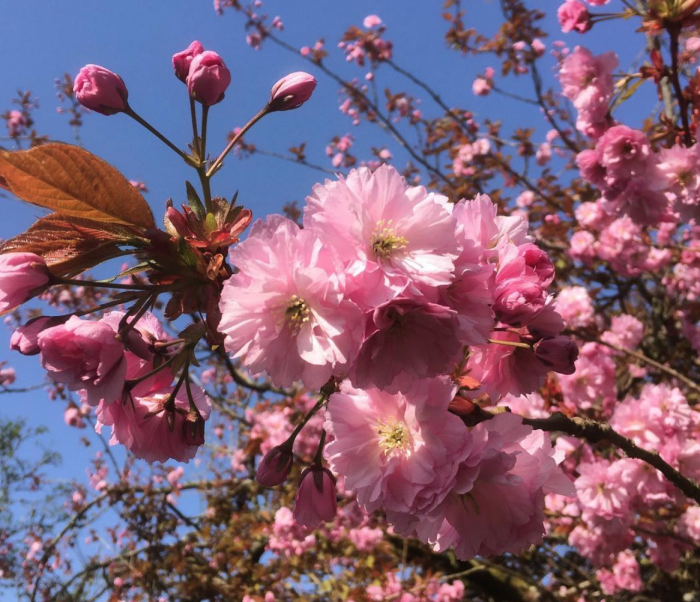
Cherry blossoms (both fruiting and ornamental varieties) have strong bitter almond flavours in their blossoms, for which they are much loved in Japanese cuisine
Most people will consume a fair amount of cyanogenic glycosides in apple pips during their lives, and this is not problematic. To put this into perspective, an average healthy human would have to eat about 54 grams of apple pips to become life-threateningly ill – that’s about 2000 pips in one sitting. And as pips and seeds are generally evolved to pass through digestive systems, you’d also need to crush them first. The point being, you’d have to work pretty damn hard to kill yourself with apple pips! I can’t find any specific data on the the cyanogenic glycoside content of rowan buds, but a healthy person would need to consume quite a lot to endanger their health.
You can read more about the chemical safety of almond tasting species here.
Nibbling a few fresh sweet buds from a rowan tree won’t do you any harm, and is one of the great sweet treats of spring.
If you still feel nervous, the good news is that hydrogen cyanide is destroyed by heating to 70ºC, so syrups and jams should be quite safe. What to do with them…? Here are a few ideas and recipes:
- Infuse them into milk to make an almond flavoured custard
- Infuse into cream to make a decedent ice cream
- Blitz them through cake and frangipani mixes
- Infuse them into anything really!
- Syrup is a good way to go….
Rowan Bud Syrup Recipe
You could substitute any of the other almondy tasting buds and blossoms mentioned above for the rowan buds, but remember that some are quite bitter compared to rowan or whitebeam.
- Place young rowan flower buds and very young leaf buds in a pan
- Cover with cold water, measuring how much water you use
- Add 100 grams of sugar per 100 ml of water. You can make a stronger, thicker syrup by adding up to twice the amount of sugar as water. Stronger syrups keep better.
- Turn on the heat and stir to dissolve the sugar
- Raise the temperature to 70ºC. If you don’t have a thermometer, this is just above the temperature most humans can rapidly dip a finger into without getting scalded! I do actually use this method myself, but i’m clearly a dangerous and stupid person! 😉
- The longer you go over this temperature, the less almond flavour your syrup will have
- Leave to cool
- Strain into bottles sterilised to a degree commensurate with your fussiness over hygiene, how long you intend to keep the syrup, and how much you can generally be arsed with that sort of cleaning rigmarole. Don’t throw away your syrup-coated buds! See below…
- Adding 10% vodka to your syrup will increase its keeping qualities, or keep in the fridge, or freeze in plastic bottles
You can use this syrup for pouring on puddings, pancakes, waffles…whatever you fancy. Or use it in baking instead of imported almonds. And once you have a syrupBest of all, use it to sweeten cocktails and liqueurs.
Don’t waste the syrup covered buds – they can be dehydrated to make crunchy almondy sweets. Or better still a delicious almond liqueur…
Rowan Liqueur Recipe
In honour of the highland heritage of rowan trees, and the very well known Italian almond liqueur brand I call this a-McRetto and it is a great favourite with Mrs Wildfood!
- Make the syrup as described above
- Put the syrup covered rowan buds left over into a kilner jar
- Cover with cheap vodka
- Leave to steep for about 4 weeks, giving it a wee shake every now and then
- Strain out the rowan buds
- Taste the vodka and sweeten (if you wish) with the rowan bud syrup you made earlier, to taste. By adding more syrup, you are reducing the strength of the liqueur. About 20% – 25% ABV is about right for our household. Almond liqueurs are usually made very sweet, but you can suit yourself.
If you want to crank up the almond flavour, you can add more fresh buds to the vodka, but remember that you are essentially extracting a precursor to cyanide by doing this, and adjust how much you drink of the resulting liqueur accordingly!
Rowan Bud Whisky Cocktail – The Godfather of Soil
This is the wild variant of the classic Godfather whisky/amaretto cocktail. I got the foraging-appropriate name from a nickname given to a lovely old farmer (who liked a dram) on Arran called…James Brown!
- 20ml of rowan liqueur
- 60ml of whisky (Scotch works, bourbon is lovely for this drink)
- Stir over ice
- Bruise a rowan bud and serve on top – the aroma from the bud should enhance the drinking experience. Berberry blossoms are also in season at this time of year, and make a very pretty garnish too.
A nice variation on this I call The Godfather of Sour :
- 30ml whisky (Scotch is good, bourbon is better in this instance)
- 30ml Rowan bud liqueur
- 20ml Sea buckthorn juice (or 30 ml lemon juice)
- 10ml Rowan bud syrup (or to taste)
- 1 Egg white
- Shake all ingredients with ice in a cocktail shaker
- Strain out the ice and shake again (this is called a reverse dry shake, and helps to emulsify the egg white, which gives the lovely creamy texture to the finished drink. You can leave out the egg white if you are squeamish)
- Fine strain into the glass of your choice
- A nice garnish for this is berberry blossoms, which are both floral and sour.
Rowan Bud Gin Cocktail – The Budding Botanist
If you are feeling a bit more ambitious, this is a great way to combine the early flavours of spring using a range of early spring flower buds and leaf shoots. I developed this recipe for my friends at Bruichladdich Distillery.
- 50ml The Botanist Gin
- 25ml Rowan shoot liqueur
- 15ml Magnolia petal/bud shrub : (Infuse some magnolia petals in cider vinegar for 4 days and some others in blossom honey for 4 days, then mix vinegar and honey to taste).
- Sweet cicely soda to taste : Rapid infuse a handful of sweet cicely leaves in mineral water using an iSi cream whipper and 2 charges of N2O then releasing the pressure, straining and recharging with one of CO2
- Sweet cicely tincture : Made by infusing sweet cicely leaves and stems in strong neutral spirit for 1 week
- Garnish with mahonia/berberry blossoms and baby rowan buds
- Method: Stir the gin, liqueur and shrub over ice. Strain into glass with ice. Add soda to taste, stiring gently. Scatter garnish. Mist with sweet cicely tincture.
Related Posts:
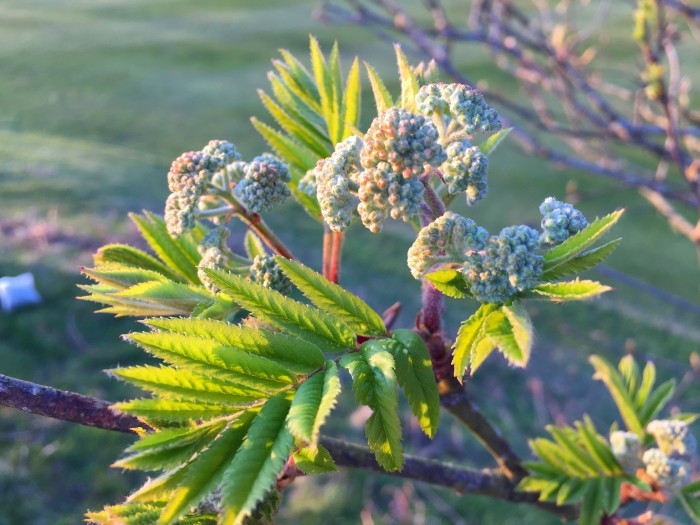

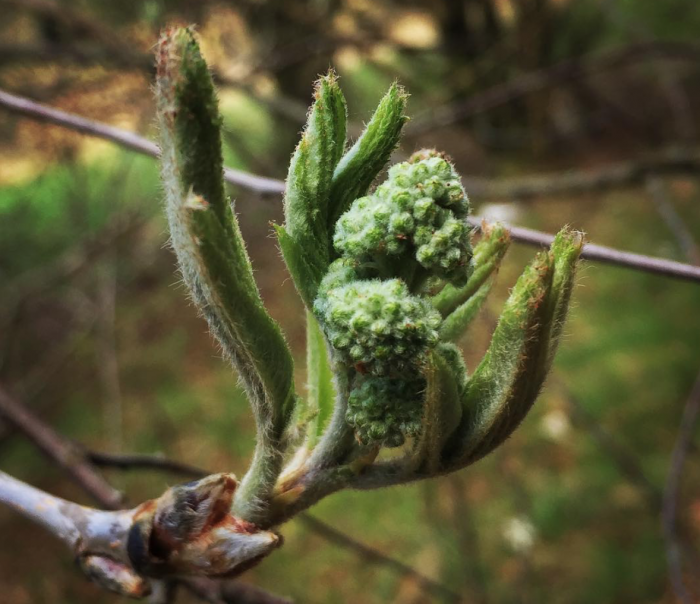
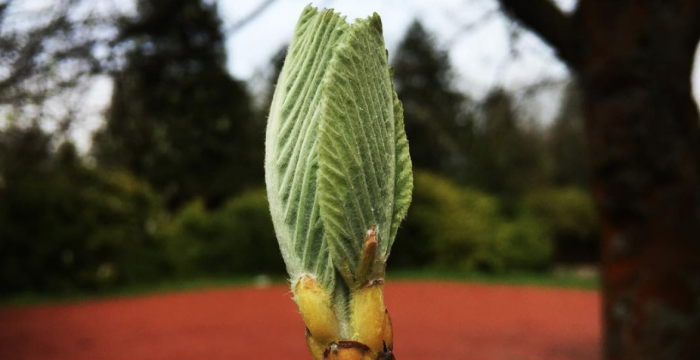
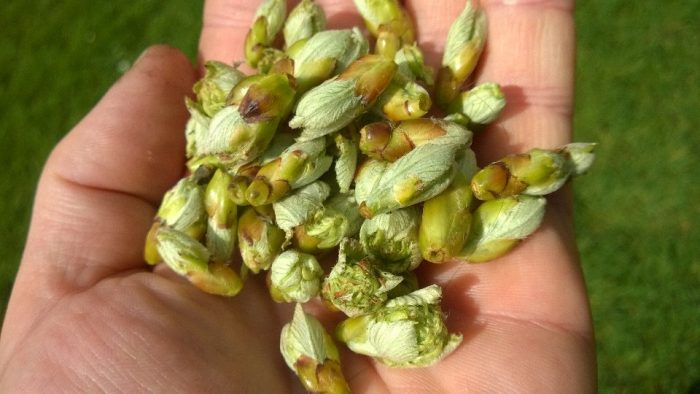
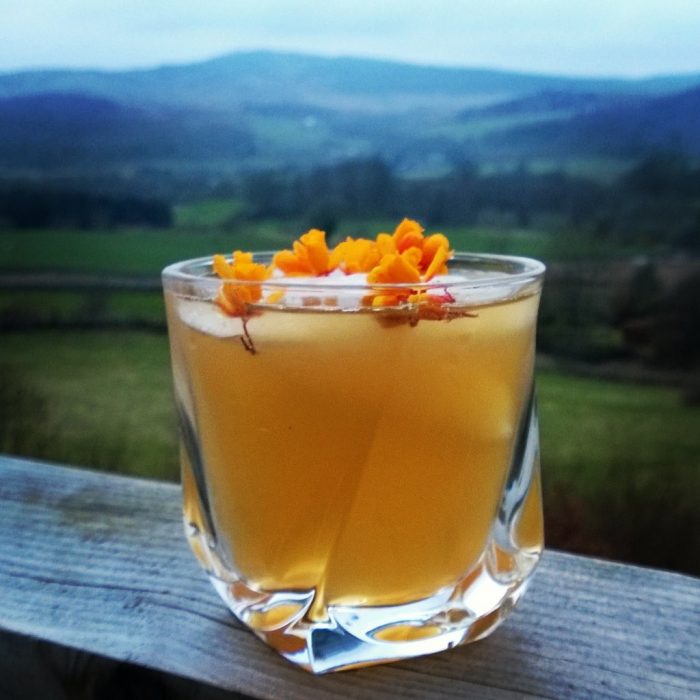
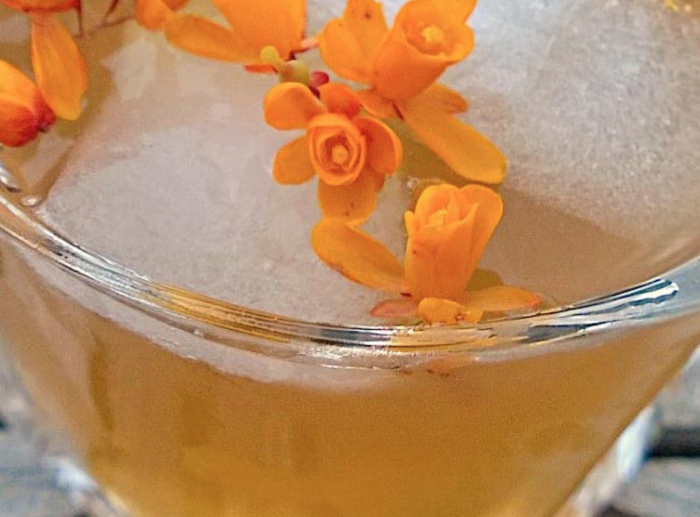
13 Comments
Hi-been considering making tea from slightly older whitebeam leaves. We picked some to identify-a few different varieties in Ireland- left some to dry by mistake and they now smell delicious, a wee bit like Earl Grey…very wee bit. Have you any thoughts on why this shouldn’t be possible?
Hi. Main thing to consider is the hydrogen cyanide precursor discussed in the post, but this is denatured at 70ºC, so should be fine for making tea.
Hi, just learned about rowan leaf buds from a foraging workshop in Finland. The presenter mentioned having to boil the buds for 12-24 hours (which I now understand from your post it likely has to do with the cyanide thing). What’s your take on this? How long should they boil for to make the syrup? Thanks!
Hi Alanna,
I can’t add much beyond what I discuss in the post – “hydrogen cyanide is destroyed by heating to 70ºC”. I have never heard of anyone boiling them for 12-24 hours before. This strikes me as extremely cautious, and the resulting sludge is likely to be devoid of flavour as well as anything else! I simmer my rowan bud syrup for no more than 5 minutes, after which the flavour falls away very rapidly, to the point its not worth doing.
Mark.
Hi Mark, do rowan leaves also contain cyanide? I was thinking of just blitzing them into a paste and freezing to later use in baking. I picked some flower buds too to to make syrup and liquor:) first time doing it. Exciting! Love your website, all that knowledge so generously shared
Hi Lena, Yes, they contain similar levels to the buds. Whenever you taste that almond flavour in nature, its probably the precursor to hydrogen cyanide. Follow the info in the post to render them safe/stick to a safe dosage. 🙂
Hey Mark love your article as We have one of these great trees growing in our yard here in Canada. The berry output this year is just incredible. The robins and the chipmunks just love the berries. I was wondering if you have a recipe for jam or jelly using these berries? I did come across one that called for equal amounts of the berries and apples, I closed the link by accident and will have to find it again. I figured you might have something considering the write up you presented here, thank you very much in advance.
Dale
Thanks Dale.
I’m not personally a great fan of rowan berries. They are so bitter and astringent that it takes huge amounts of sugar to make them palatable to most people. Its not that they aren’t a useful resource that can be made flavourful, its just that there are a dozen other fruits that I prioritise harvesting over rowan. As a result, i’m not the right person to ask for recipes for them! Though you could certainly use them in my fruit leathers recipe: https://gallowaywildfoods.com/super-simple-wild-fruit-leathers/
Rowan jelly is a popular condiment with cold meats in the UK, so you should find lots of recipes for that elsewhere online.
Best wishes,
Mark
Iv read somewhere that if you freeze them it takes all the bitterness out and they end up being really sweet? Iv a huge tree in my garden, most of it is in bloom with the flowers now. Love foraging and have made a lovely dandelion honey great article? Have you a Facebook or YouTube page/channel?
I have frozen rowan buds in the past. Can’t say I noticed them becoming sweeter as a result.
Yes, you can find me on twitter, FB and Instagram – click on the relevant icon on the top right of this page if you are on a computer, or at the very foot of the page if you are on a mobile device. 🙂
Hi Mark, I just want to double check – when you make your syrup, do you take it just to 70 degrees and then let it cool down? No simmering? I found it very hard to control the temperature. It shot up to eighty so I let it cool down. Then I wondered if I’d cooked it enough so I did that again. This discovery is an absolute joy by the way.
Hi Felicity,
Holding it around 70 degrees for a few minutes should be enough – so having raised the temp a couple of times, i’m sure you’ll be fine. Its not an exact science! If you over-heat, you lose lots of the flavour.
Cheers
Mark.
I see you mention drying the buds after cooking, have you tried dehydrating the fresh flowerbuds? Oh, I should mention your website is fantastic.